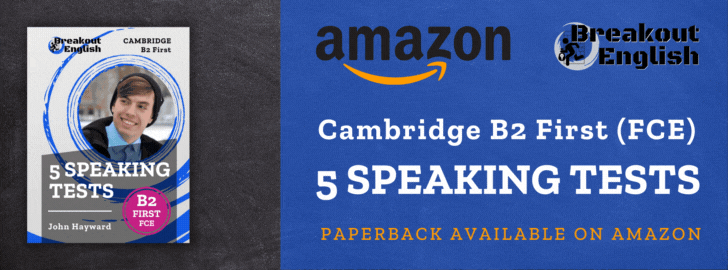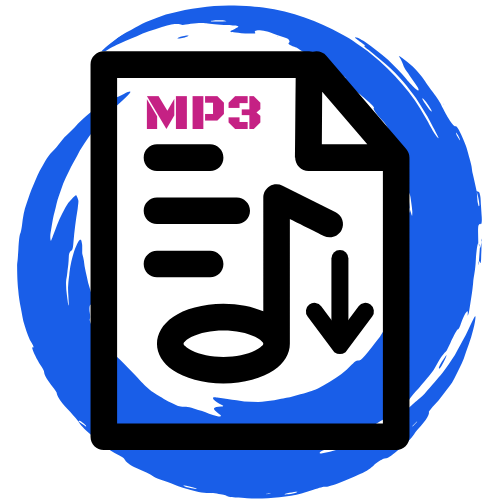FCE Speaking Part 2 is also called the “long turn”. In fact, it’s only a minute long, but for B2 First Certificate candidates, that minute can seem like an eternity. During the long turn, candidates are asked to speak by themselves for a minute about a pair of pictures and to answer a question about those pictures. Their partner is then asked a short follow-up question about the same pictures. Having some FCE Speaking Part 2 useful phrases ready to go can make a big difference to both your final result and your confidence going into the exam.
Whether it’s strange FCE Speaking Part 2 pictures, strange questions or just nerves, this part of the exam causes a lot of anxiety for many candidates. However, it is very trainable. So, what we can do to help?
In addition to the free materials on this page, you can find 5 complete First (FCE) Speaking exams as part of Breakout English’s premium materials collection.

Contents
How to train for First (FCE) Speaking Part 2
First and foremost, you’ll need lots of practice with this part of the exam. If you don’t get that practice, you are bound to feel nervous when it comes time to speak alone. Remember, a B2 level speaker is not always completely confident in their own ability, despite often having quite a substantial bank of language to draw upon.
Get prepared with structures and useful phrases to use when organising the long turn. Unlike our Preliminary (PET) perfect speaking plan, I don’t recommend a strict plan at this level, but rather a helping hand with language that will help to fill the minute and improve discourse management score during the exam. Check out some useful language below.
Force yourself to use the target language. In a classroom, give one student a checklist of language and if they hear their partner use that language while speaking, they cross it off the list. Turn it into a game and give points for each useful phrase they use.
Be strict about time limits. It’s easy to ramble on about pictures for more than a minute, but that’s not what will happen in the exam. You need to organise and complete the task within the given time. Stop your partner with your best Cambridge examiner “thank you”.
Promote use of less common vocabulary. After studying a vocabulary topic, find some pictures related to the topic of your FCE Speaking Part 2 and use it while comparing the pictures. Write down the target vocabulary and have in front of you during the task. In a classroom, put it up on the board. You could even start banning overused vocabulary to force yourself to use the more advanced stuff.
Practise again. Practise as a warmer, cooler, filler and inbetweener. Practise with a teacher, a friend, the mirror or your dog. In the classroom, make the students the examiner in groups of three and practise like that. Practice makes perfect.
When you’re ready, you should be tired of seeing pictures. If you’ve prepared well, you can do it with your eyes closed, but then they wouldn’t be able to see the pictures.
First (FCE) Speaking Part 2 Useful Phrases
Other than vocabulary related to whatever the topic of the pictures is, the best thing you can do to prepare is to have a selection of FCE speaking Part 2 useful phrases to organise the long turn and speculate.
Indicating which picture you are talking about
- there are two pictures of
- in the first picture, in the second picture, in both pictures
- the first one, the second one, the picture on the top/bottom, the picture on the left/right
Contrasting the pictures
- but, so, and
- on the other hand
- in contrast
- whereas
- while
- the other picture is different because
Speculating
- possibly, probably
- might be, may be, could be
- it’s likely that, it’s possible that
- I guess , I imagine, I suppose
- maybe, perhaps
- seems, looks like
All this language is used in the materials below.
FCE Speaking Part 2 Example
Here is an example and some First (FCE) Speaking Part 2 pictures to describe.
| In this part of the test, I’m going to give each of you two photographs. I’d like you to talk about your photographs on your own for about a minute, and also to answer a question about your partner’s photographs. (Candidate A), it’s your turn first. Here are your photographs. They show people shopping in different places. I’d like you to compare the photographs, and say why the people might have chosen to shop in these places. All right? One minute Thank you. (Candidate B), where would you prefer to shop? …… (Why?) Approximately thirty seconds Thank you. |

The Materials
These FCE Speaking Part 2 materials have been designed to provide your students with useful language for the exam and to get practice with different pictures. The topic of all the pictures is shopping, so it would fit in perfectly with a shopping unit in a coursebook.
You can also use these materials to practise on your own. Just work your way through the tasks and do the speaking parts by yourself. If you are working alone, use a voice recorder on your mobile phone to record what you’ve said. A day or two later, listen again and try to spot your own mistakes. You’ll hate listening to yourself at first, but the effort will pay off.

CLASSROOM PROCEDURE:
First, listen to the example and get your students to discuss what was good about it. I would recommend folding the worksheet here or only projecting the images from the example.
Students then work to categorise the FCE Speaking Part 2 useful phrases that were used in the example.
Give feedback on the useful language and drill some pronunciation.
Have your students practice in pairs. There are 3 more sets of FCE Speaking Part 2 pictures just in case you need to do groups of 3.
Check here for even more FCE Speaking Part 2 pictures.
Extension: Have your students brainstorm possible follow-up questions and practise them.
EXAM PART: FCE Speaking Part 2
EXAM SKILLS: Comparing and contrasting, discourse management
TOPIC: Shopping
TIME: 20-25 minutes + extension
PREPARATION: One copy of the worksheet per student, speaker or computer to play the audio file
Download



